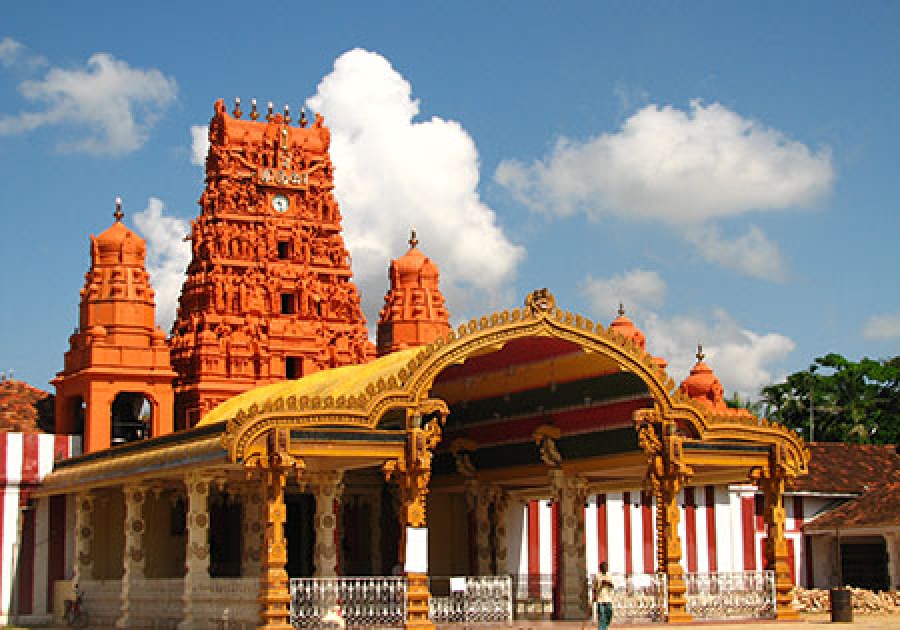
Sunday, 7th September 2014
By J. Yogaraj

Nallur kovil has become the symbol of reconciliation and peace in an island nation which is recovering from a war
People change from time to time. There can be many reasons and factors for a change of mind. When someone realizes that he is making a mistake, he may change his mind or some people wait until others point out the mistake. People make mistakes. It is human nature. But we must make sure that, people should not be prone to making mistakes. If you make a mistake the first time, you will be pardoned. But, you might not be the second time. If you keep on doing the same mistake, then it cannot be termed as a mistake, but it can be taken as intentional. You may face a penalty or deemed to get a punishment.
Before the war, Tamil people in the country and Tamil diaspora had a different mindset. But after the end of hostilities in 2009, Tamils in this country have realized the truth. Now they are slowly getting attached to the national parties and have begun to display patriotism.
It is not only the individuals, but the countries too have changed their perceptions. The present BJP government in India has a clear policy about the Tamil issue, which is well appreciated. The central government of India maintains a better relation with Sri Lankan government. But it is unfortunate to see that some of the Tamil Nadu politicians still pursue the LTTE supportive policies. Tamil Nadu politicians talk about Sri Lankan Tamils, but when it comes to Fishermen problem they take the Tamil Nadu side, which is ridiculous.
When the Indian government proscribed LTTE, naming it a terrorist organization, some LTTE supportive elements in Tamil Nadu and in Europe demanded the ban on LTTE to be lifted. But one question remains unanswered. They argue that if an organization does not exist, why should we ban? As a result another question arises. Who are the people asking to lift this ban? Can we think these elements are LTTE supportive elements, which establishe the fact that there is an emerging force or an existence of LTTE elements? A moderate Tamil will find it difficult to answer this, but Tamils hate these activities and perceptions. Ordinary Tamils in Sri Lanka do not want to see LTTE again. They suffered a lot under LTTE iron grip. They do not want to face that situation again.
Today Tamil Diaspora is divided into three. Perhaps half of the people have become balance minded. But they are keeping silent. No one from this group is interested in making their opinion public. Then around one third of the people, still have interest in supporting the LTTE. They have some good speakers. They always try to speak out and make statements in public. The other group of people have changed a lot and started showing their gratitude to the motherland – Sri Lanka. This is the present situation of Sri Lankan Tamils.
Whether you fall into which group in the Diaspora, does not matter. The members of the Tamil Diaspora always have a practice to visit Sri Lanka regularly. This clearly shows that even the controversial members of Diaspora have started to realize that there is real peace in the country. Otherwise, they will not invest large amounts of money in Northern Province. They come here to meet their relatives, to buy lands and houses and even to get married. But one important event they will not forget. It is the Nallur Kovil Festival.The festival falls in the month of August every year. Nallur Kovil Festival is one good example to change the contradicting minds and promote patriotism.
Annual festival
Nallur is a town in the northern Jaffna District. It is located 3 km south from the Jaffna city centre. Nallur is famous for the Nallur Kandaswamy Temple a popular place of worship and respectively the largest Saiva temple on the peninsula. It is also famous for being the historical capital of the old Jaffna Kingdom and birthplace of renowned philosopher and theologian Arumuka Navalar.
Although Nallur festival is considered as the religious festival for Hindu devotees, now it has changed a lot. The demography and culture of the people are changed in such a way to accommodate other communities into the forum. Thus it sets an example to others. People in this country know about Nallur, which is a town area. When we think of Nallur, the temple comes to our mind, whether you are Sinhalese, Tamil or Muslim.
Nallur Temple is one of the most significant Hindu temples in the Jaffna District of Northern Province, Sri Lanka. This Kovil hosts the most prestigious NALLUR FESTIVAL every year with a Koddiyetram. The presiding deity is Lord Murugan in the form of the holy Vel. The idol of the Nallur Devi or goddess was given to the temple in the 10th century CE by the Chola queen Sembiyan Mahadevi, in the style of Sembian bronzes.
The “Mahotsavam” (annual Great Festival) begins with “Kodietram” (Hoisting Holy flag) on the sixth day following “AadiAmavasai” (the New Moon in the Tamil month of ‘Aadi’) and continues for twenty five days. The cloth for hoisting is obtained ceremonially from the Saddanathar Temple in the neighborhood. This temple was patronized by Ariyachakravarthi – one of the kings of Jaffna Kingdom.
During the festival days various “Yaagams”, “Abishekams” and special poojas are conducted. The Deity goes round the inner precincts at noon and the outer precincts in the evening daily. Lord Skanda or his vel, as the case may be, does the rounds by the “Vahanams” (Vehicles) like Silver Peacock. Silver Swan, Silver Rishapam(the Cobra), the green Peacock, the House and etc.
The huge, heavy chariot carrying the statue of God Muruga is paraded along the streets of Nallur shrine. It is pulled by a rope by thousands of devotees where the rich and poor, old and young stand shoulder to shoulder in pulling it giving God Muruga the opportunity to witness the sincerity and purity of the devotees. The next day is the water cutting ceremony which is called in Tamil ‘Theertham”.The final religious activity of ‘Theertham” is lowering of the flag – “Kodiirrakkam” in Tamil.
Socio–cultural role
During all days of the Nallur festival, worshippers are fed with quality lunches. This activity takes place in various “Madams” around the temple. The word “Madam” in Tamil refers generally to a religious establishment which does social and religious activities.Everywhere we saw large decorated cadjan sheds built by various private organizations. They supply freely cooled drinks during day time and some of them supply milk tea in evenings. The worshippers can rest in the sheds sitting on the white sand during the day time.
During the evenings, parents with their kids, elderly people and youngsters accompanied by their friends sitting on the silver sandy area around the temple in all directions, usually take rest and have conversations for long hours. During these times they enjoy music or art programs staged in the open spaces and halls around the temple, after the pooja comes to an end. Small children and young people often create temporary divine statues by using the white sand.
Traders competitively invade Nallur area during festival time. They install stalls. The southwest and west areas around the temple take the form of fair or exhibition. During this time, both big and small companies open shops and exhibit their goods and products to potential buyers. They also inform people of their business and also educational and job opportunities. Many food stalls serve delicious food items. The varieties of food range from those which are sweet and chilly flavored to short eats.
Nallur Temple Trustees implement a strict dress code and guidelines for male devotees entering the temple. Male devotees should remove their shirts when they enter the temple. It is observed that all the visitors coming from south of Sri Lanka and members of Armed Forces and the Police respect the cultural values and traditions of Nallur. Even when President Mahinda Rajapaksa visits Jaffna, he always makes a visit to Nallur Kovil. As a head of state, when he visits the temple he always make it a practice to adhere to the customs of the kovil. This sets an example to other citizens of this country. Thus the kovil has become the symbol of reconciliation and peace.
The historic festival draws devotees from around the island as well as overseas. Many families of expatriate Tamils living in Europe, Canada, USA and Australia show interest in visiting their native land, Jaffna, during the festival season . They stay in Jaffna for one or two months and take part in the Nallur festival.
The writer is a senior journalist –
From: http://www.nation.lk/edition/lens/item/33017-nallur-as-an-agent-of-change.html




